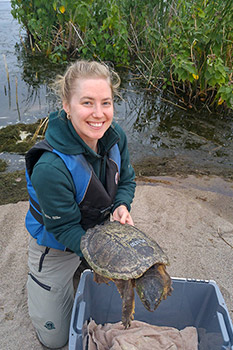Meet Tarra Degazio
Point Pelee National Park

Job Title
Resource Management Officer
What was your education/career path?
My first post-secondary career path was to become an animator, and so I took Dessin d’animation classique 2D/3D at Collège Boréal. I changed paths after completing this course and took a short certification course in Teaching English as a Second Language (TESL), with which I taught English in China for a year. While there, I rediscovered my passion for the environment, and upon my return applied to Laurentian University for Aquatic and Terrestrial Ecology and completed my Bachelor of Science (Hons).
What drew you to Point Pelee? When did you first start working at Point Pelee National Park?
When I was nearing completion of my BSc (Hons.), I began applying to a variety of positions across Canada related to ecology and wildlife. I was drawn to apply at Point Pelee National Park as there were many interesting active management projects mentioned on the website which would allow for a wide range of learning experiences. I then began working at Point Pelee National Park in July of 2013.
What do you do for Parks Canada?
Currently I am part of a great team working on the park’s Marsh Restoration Project which targets invasive vegetation management. This includes the writing of an impact assessment for any natural or cultural resources which could be affected by project activities, collecting data within areas to be managed, and collaborating with researchers conducting wetland related work.
Before this project, I was contributing to the implementation of ecological integrity monitoring within the park. This entails monitoring, data input, analysis, and reporting on a number of natural resources in the park which are deemed to be good indicators of ecosystem health. Some examples of these natural resources include forest trees and seedlings, southern flying squirrels, eastern prickly pear cactus, and water quality.
Additionally, I have had the chance to be involved in many projects including active management for hyperabundant species, additional monitoring/ active management for Species at Risk (ex: eastern foxsnakes, american water-willow, turtle species, eastern banded tigersnail), and more!
What would you tell a young girl about working in science, technology, engineering and mathematics (STEM)?
I struggled with mathematics, which led me to believe that I could not work in the field of science. While in University I really put my nose to the grindstone and sought help when I was struggling, which helped me accomplish what I set my mind to and more!
If there’s a certain field you want to work in but your perceived limitations are holding you back, know that there are resources out there to help you improve and knock it out of the park once you step up to the plate.
- Date modified :